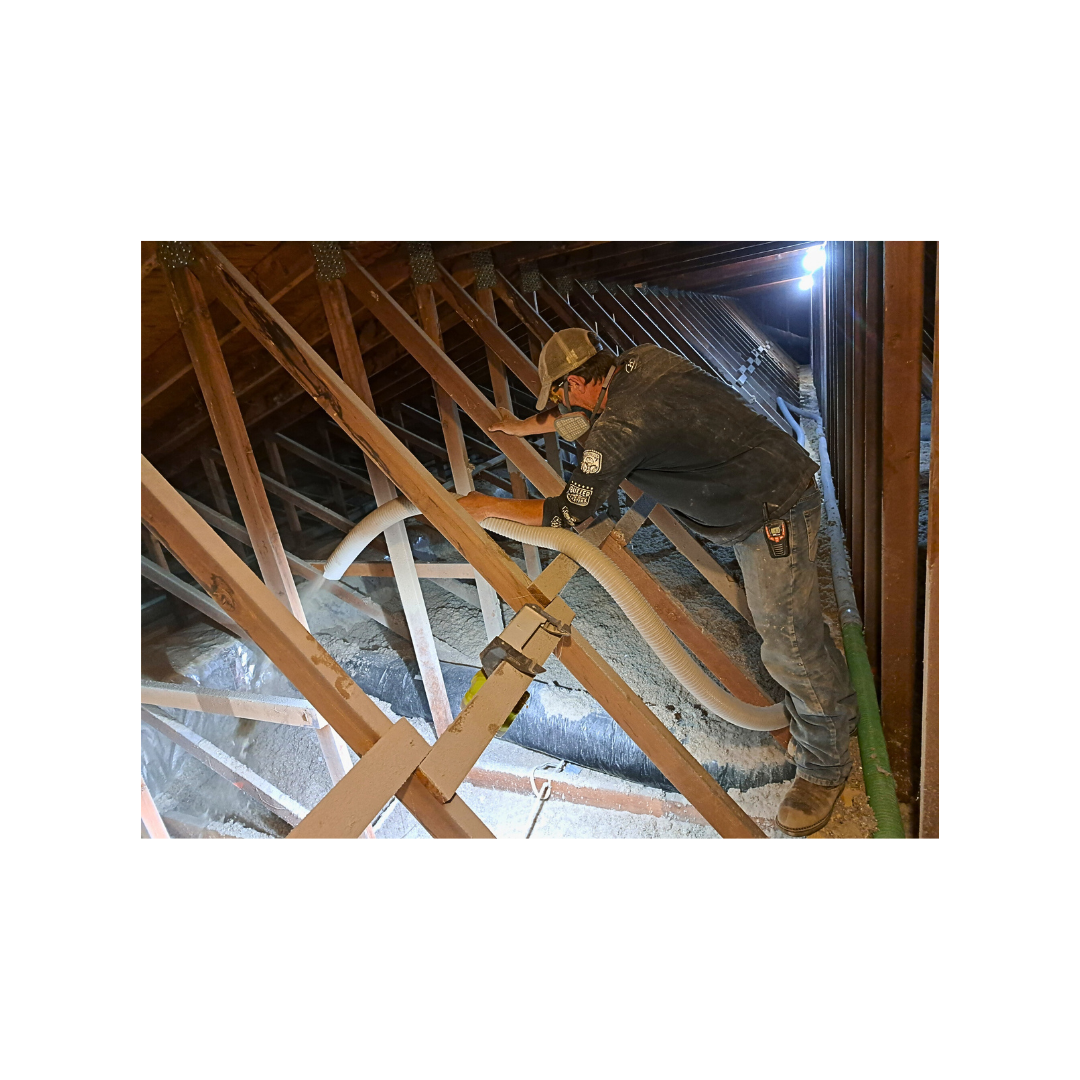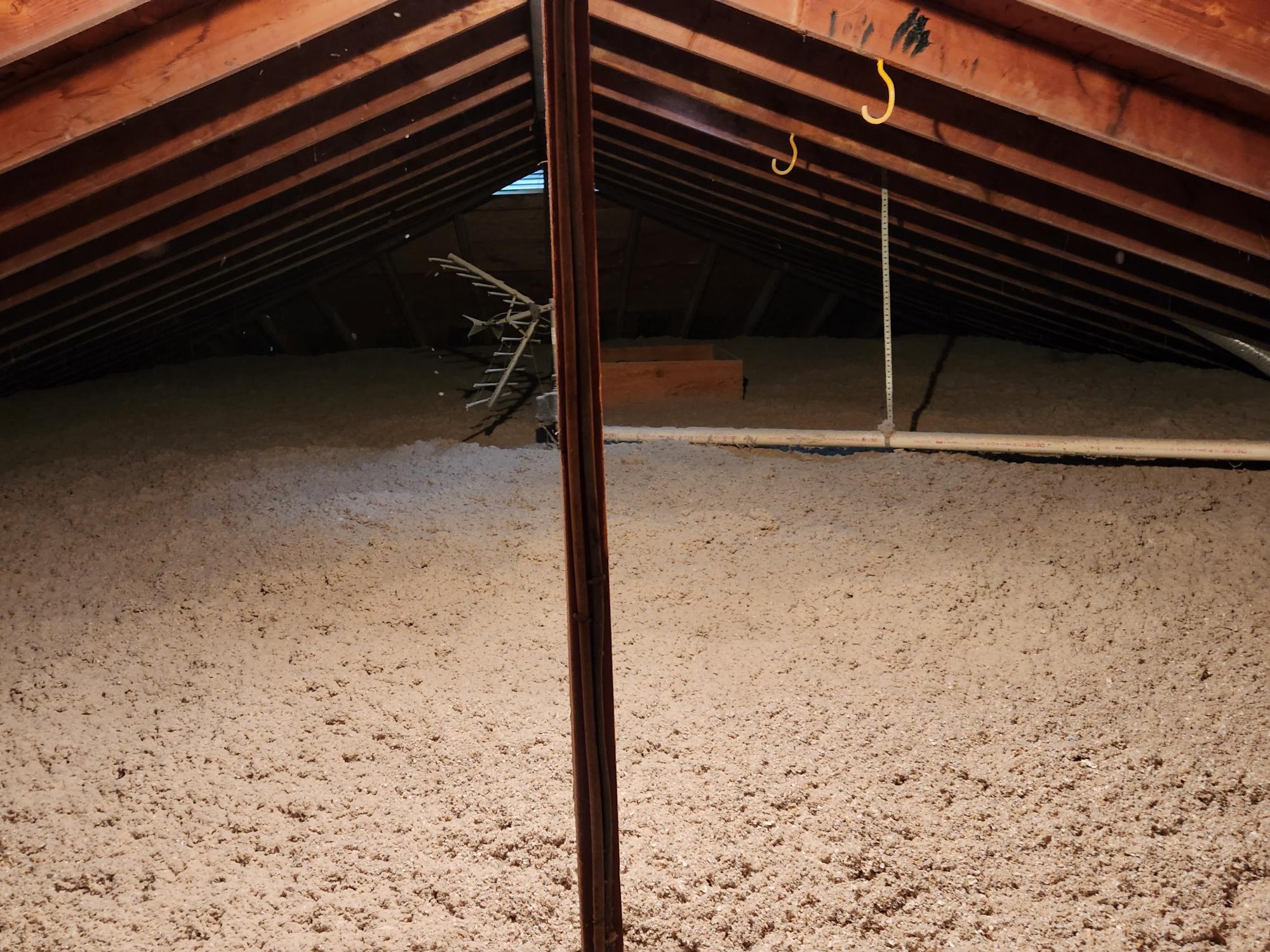Central Pennsylvania Spray Foam, Attic Blown-In, Fiberglass Batt, Air Sealing and Blower Door Testing .



Attic Blown In Insulation
Attic blown-in insulation is a type of insulation material that is installed in attics to help reduce heat loss and gain in a building. It is typically made of loose fibers of cellulose, fiberglass, or mineral wool that are blown into the attic space using a machine.
The process involves using a machine to blow the insulation material through a hose and into the attic, where it settles between and on top of the joists and other structures in the attic. The insulation material is then spread out and leveled by an installer to ensure that it is evenly distributed and provides adequate coverage.
A whopping 40-50% of your heating and cooling costs go straight out of your roof. This is the reason that attic insualtion is so important.
Attic blown-in insulation is often chosen because it is an affordable and efficient way to insulate an attic space, as it can be installed quickly and without the need for extensive construction work. It is also effective at reducing heat loss in the winter and heat gain in the summer, which can help to lower energy bills and improve overall comfort in the home.



Cellulose
Blown-in cellulose insulation has several advantages:
-
High R-Value: Cellulose insulation has a higher R-value per inch than fiberglass, which means it provides better thermal resistance and energy efficiency.
-
Sound Insulation: Cellulose insulation can also provide excellent sound insulation, making it a good choice for homeowners who want to reduce noise transmission between rooms or from the outside.
-
Environmentally Friendly: Cellulose insulation is made from recycled materials, which makes it an environmentally friendly choice. It is also treated with borates to make it resistant to fire, insects, and rodents.
-
Easy Installation: Blown-in cellulose insulation can be installed quickly and easily with a blowing machine, which means that it can be a cost-effective option for homeowners.
-
Better Air Sealing: Cellulose insulation can also help to reduce air infiltration, which means that it can improve indoor air quality and reduce energy bills.
-
Mold and Moisture Resistant: Cellulose insulation is also resistant to mold and moisture, which can help to prevent damage to the home and protect the health of its occupants.
Overall, blown-in cellulose insulation is a cost-effective, environmentally friendly, and efficient insulation option that provides several benefits for homeowners.
Fiberglass
Blown-in fiberglass insulation has several advantages over other types of insulation, including:
- Excellent thermal performance: Blown-in fiberglass insulation has a high R-value, which means it provides excellent thermal resistance, helping to keep your home cool in the summer and warm in the winter.
- Easy installation: Blown-in fiberglass insulation is easy to install and can be quickly blown into attics, walls, and other hard-to-reach areas. This makes it an ideal choice for retrofitting existing homes.
- Cost-effective: Blown-in fiberglass insulation is one of the most cost-effective insulation materials available. Its low cost, coupled with its high performance, makes it an attractive option for homeowners on a budget.
- Fire-resistant: Fiberglass is naturally fire-resistant, which makes it a safer option than other types of insulation, such as cellulose.
- Sound insulation: Blown-in fiberglass insulation can also help to reduce noise transmission between rooms, making it an ideal choice for home theater rooms or bedrooms.
- Eco-friendly: Blown-in fiberglass insulation is made from recycled materials, such as glass fibers, which reduces waste and makes it an eco-friendly choice. Additionally, it is non-toxic and does not emit harmful gases or chemicals.
Overall, blown in fiberglass is a great option for attic insulation even though it is a little more expensive and doesn't have the R-value per inch as cellulose.
Rockwool
Blown-in rockwool insulation, also known as loose-fill rockwool insulation, has several advantages over other types of insulation:
- Excellent thermal performance: Blown-in rockwool insulation has excellent thermal performance, providing high levels of insulation against heat loss in winter and heat gain in summer.
- Energy efficiency: With its superior thermal performance, blown-in rockwool insulation can help reduce heating and cooling costs, making it a more energy-efficient option.
- Sound insulation: Blown-in rockwool insulation has excellent sound-absorbing properties, making it ideal for reducing noise from outside or between rooms within a building.
- Fire resistance: Rockwool is non-combustible, so blown-in rockwool insulation provides excellent fire resistance, adding an extra layer of safety to your building.
- Moisture resistance: Rockwool is hydrophobic, meaning it repels water, making it resistant to moisture and reducing the risk of mold growth.
- Sustainable: Rockwool insulation is made from natural and sustainable materials, making it an eco-friendly insulation option.
-
Easy installation: Blown-in rockwool insulation is easy to install, with the material being blown into place using a special machine. This makes it ideal for retrofitting existing buildings or insulating hard-to-reach areas.

Draft stoppers Conclusion
At Draft Stoppers Insulation our goal is to make sure every customer gets a top quality attic blown in insulation install that makes the most economic sense for them. That's why we prefer to assess every situation before recommending which solution would be best. The majority of the time cellulose is the attic blown in product that Draft Stoppers recommends because of the effectiveness and economical returns.

